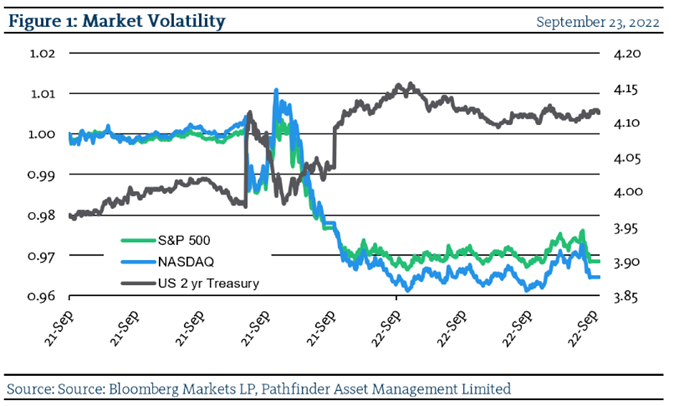A week(s) of volatility continued…
If you have been following “the markets” over the past number of weeks, you would have noticed a substantial change in sentiment. We wrote about this last week and again we find ourselves with similar thoughts. We read this morning that we are already back to within 1% of the June lows. Since then, markets had rallied on expectations that it was going to be relatively straightforward for central banks to “get a handle” on inflation. There was also the general belief that the US Federal Open Market Committee (“FOMC”) was going to be able to manage a “soft landing”. That narrative started to turn a couple of weeks ago, and then again this week, after the FOMC meeting on Wednesday and Chair Powel’s commentary. Indeed, we have seen multiple articles on Bloomberg where market pundits have shifted from predicting a soft landing to an increased chance of recession. Also, the FOMC downgraded its economic growth assumption from around 1.5% to essentially 0%, which in our view is effectively recessionary. This past Wednesday, the FOMC raised its overnight administered interest rate by 75 basis points (“bps”) to 325bps and also indicated that it would potentially raise another 75bps in December and another 25bps sometime in 2023. This was expected but the more hawkish and less constructive commentary afterwards during Chair Powell’s statement was not. We detail the market reaction in the chart.
- In Figure 1, we present the price change of broad stocks, technology stocks and short-term bonds. As you can see, there was extreme volatility on Wednesday. This resulted from release of the FOMC statement and the following statement by the Chair to the media. The chart presents real time reconciliation of market expectations with actual data. It is this disconnect between the prevailing market view and the ultimate truth that causes volatility.

“This means that” our conclusions for last week remain the same. We continue to watch carefully for opportunities. While we still believe that there is potential for further downside, we think that this would present multiple opportunities to reposition the portfolio into large weights in very high-quality companies. This should serve the portfolios very well in the years to come. Expectations of market participants can change very quickly, and this results in volatility. We expect this to continue for some time as the world works through the actual data and its future expectations. It is volatility that ultimately presents opportunities for disciplined investors.
National Instrument 31-103 requires registered firms to disclose information that a reasonable investor would expect to know, including any material conflicts with the firm or its representatives. Doug Johnson and/or Pathfinder Asset Management Limited are an insider of companies periodically mentioned in this report. Please visit www.paml.ca for full disclosures.
*All returns are time weighted and net of investment management fees. Returns from the Pathfinder Partners’ Fund and Partners’ Real Return Plus Fund are presented based on the masters series of each fund. The Pathfinder Core: Equity Portfolio and The Pathfinder Core: High Income Portfolio are live accounts. These are actual accounts owned by the Pathfinder Chairman (Equity) and client (High Income) which contain no legacy positions, cash flows or other Pathfinder investment mandates or products. Monthly inception dates for each fund and portfolio are as follows: Pathfinder Core: Equity Portfolio (January 2011), Pathfinder Core: High Income Portfolio (October 2012) Partners’ Fund (April 2011), Partners’ Real Return Plus Fund (April, 2013), and Partners’ Core Plus Fund (November 2014).
Pathfinder Asset Management Limited (PAML) and its affiliates may collectively beneficially own in excess of 10% of one or more classes of the issued and outstanding equity securities mentioned in this newsletter. This publication is intended only to convey information. It is not to be construed as an investment guide or as an offer or solicitation of an offer to buy or sell any of the securities mentioned in it. The author has taken all usual and reasonable precautions to determine that the information contained in this publication has been obtained from sources believed to be reliable and that the procedures used to summarize and analyze such information are based on approved practices and principles in the investment industry. However, the market forces underlying investment value are subject to sudden and dramatic changes and data availability varies from one moment to the next. Consequently, neither the author nor PAML can make any warranty as to the accuracy or completeness of information, analysis or views contained in this publication or their usefulness or suitability in any particular circumstance. You should not undertake any investment or portfolio assessment or other transaction on the basis of this publication, but should first consult your portfolio manager, who can assess all relevant particulars of any proposed investment or transaction. PAML and the author accept no liability of any kind whatsoever or any damages or losses incurred by you as a result of reliance upon or use of this publication.